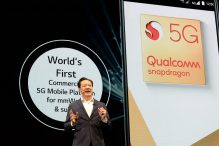The Next Generation: Five Things To Know About 5G
The next generation of mobile broadband, 5G, is distant on the horizon. There is still so much untapped potential in 4G LTE (which, theoretically, could reach download speeds of up to 100 Mbps) that 5G is not on any American provider’s priority list just yet. In fact, when Japanese provider Huawei and Russian provider MegaFon announced a partnership with plans to introduce 5G for the 2018 FIFA World Cup in Russia, they were met with some skepticism from the industry [1]. Three years just seems too little time to build a network that could significantly surpass the performance of 4G LTE.
Although most mobile network investments are private ones, the United States and the European Union are just two of the many governments currently investing in 5G
Still, everyone who has experienced a profound change in mobile broadband caused by the introduction of the 4G LTE network is curious to find out what changes 5G will bring. Despite a lack of practical developments, the industry is already conceptualizing the new network and the 5G standard at the 2015 Mobile World Congress, among other places. It is possible, therefore, to satisfy our curiosity about 5G years before it is built. Here are five facts/speculations about the much-anticipated next generation:
- 5G’s performance won’t be measured in download speed. So far, each generation of mobile networks has had an exponentially faster peak bit rate than the generation before, but skeptics argue that 4G LTE (with its potential downlink of 100 Gbps) closes in on the speed limit of land-mobile radio [2]. Yes, 5G will be faster than 4G LTE, but probably not because of an exponential bit rate increase. Instead, engineers are likely to focus on secondary speed factors like system spectral efficiency and latency, where there is more potential for development.
- 5G is all about volume. When it comes to the future of mobile networks there are a lot of differing opinions out there. The one thing everyone agrees on, however, is that 5G needs to support a large volume of devices without compromising network performance because, first, more and more people are using the mobile Internet and, second, an increasing number of machines (watches anyone?) are being connected to wireless networks. It’s no coincidence that Huawei and MegaFon chose the World Cup as the event at which to introduce 5G: a stadium full of a million smartphones is exactly the type of situation 5G is meant to address.
5G will be built to handle the growing volume of devices connected to the mobile network
- 5G will make your battery last longer. Batteries are immune to Moore’s Law (the theory that every two years, the capabilities of digital electronic devices double) because they are governed by chemistry more than by electronics. As a result, users are constantly frustrated by short battery life. But there are two ways to make a battery last longer: number one, build a stronger battery or, number two, build a gentler network. Smartphone applications are constantly sending requests to the network checking for new emails, updates, etc. These requests waste battery power even when the device is not in use. They are the subject of new 5G research aimed at decreasing the demand mobile networks put on batteries [3].
- 5G will be cheaper than 4G. Today providers are struggling to reconcile the rising demand for data with the fixed unit cost of data transport over the 4G LTE network. The high cost of data transport caused providers to eliminate Unlimited 4G plans in the early 2010s (when mobile data use took off) and, instead, charge users per GB of data. Besides being expensive to transport, there is a limited supply of 4G LTE data, not enough to meet demand. The result: users pay too much for 4G LTE and providers lose profit because they can’t fully meet demand. The inefficiency of 4G is less than ideal. Providers are interested in adopting more efficient networks that could serve more users at more competitive prices. By implementing new strategies like the Demand Attentive Network [4], providers can offer 5G access that is less expensive than 4G LTE.
- It’s coming in 2020. A new generation of the mobile network is launched approximately every 10 years. If 5G follows suit, which industry experts predict it will, the next generation should be here in five years.
Unlimited 4G LTE and 5G Wireless Kits | Broadband And Wireless Devices | EvdodepotUSA
[1] Huawei hopes to score at World Cup 2018. Available at: https://www.cnet.com/news/huawei-megafon-to-build-5g-mobile-network-in-2018/
[2] Advanced Feature & Future of Wireless Networks. Available at: https://www.academia.edu/7788733/Advanced_Feature_and_Future_of_Wireless_Networks_-_5G
[3] If You Think 5G Is All About Faster Network Speeds, You’re Wrong. Available at: https://www.businessinsider.com/5g-network-speed-2014-7





